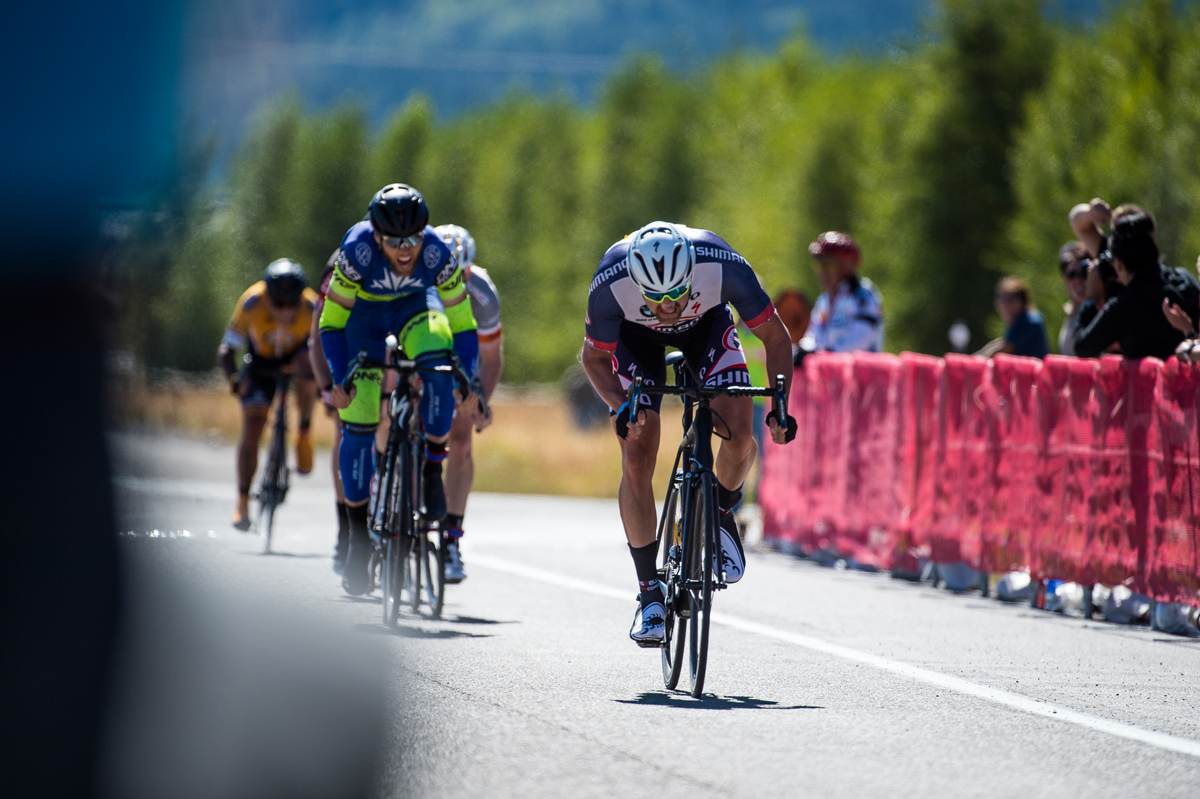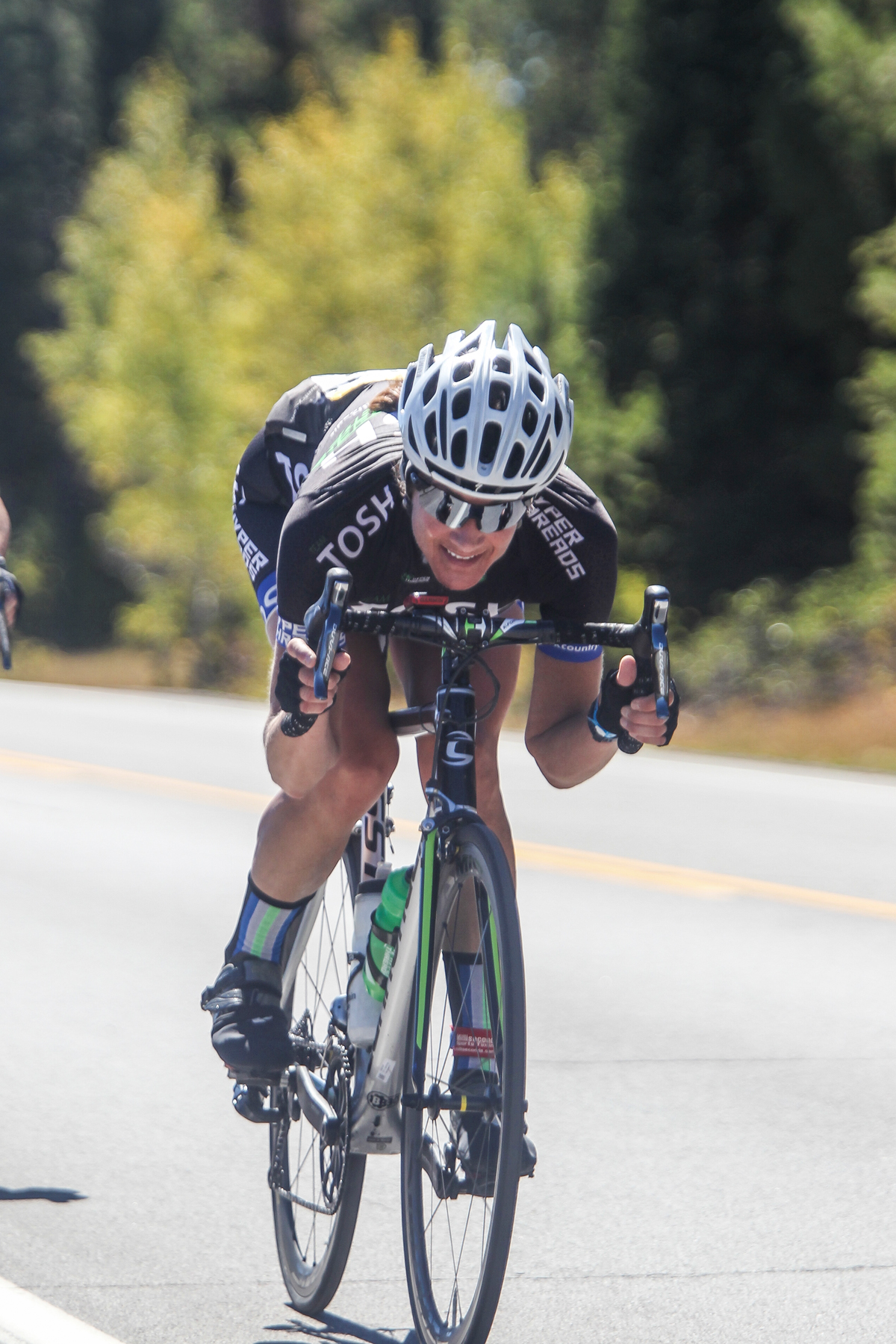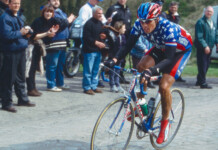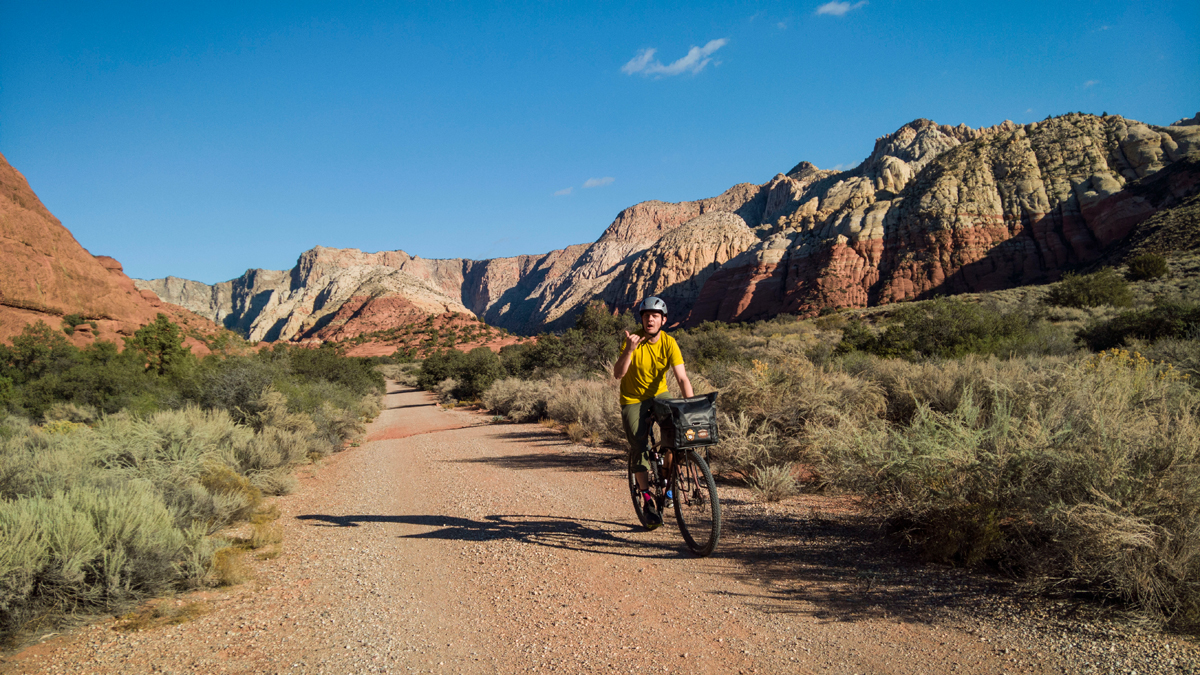Sorensen celebrates second consecutive LoToJa victory and Kimball gets her wish to cross the line alone to win
[Editor’s Note: All of Ira Sorensen’s USA Cycling results dating back to 2011have been vacated after he tested positive for testosterone at the 2018 edition of LoToJa, and was suspended by USADA]
By David Bern — The top male and female winners of the 34th Annual LoToJa Classic are no strangers to the race’s victory podium.
On Sept. 10, Ira Sorensen (Canyon Bicycles) kept the Men’s Pro 1-2-3 crown that he won last year after yet another decisive sprint over five breakaway companions. His winning time was 8:55:59 — nearly two minutes faster than last year.

“I really didn’t have any expectations going into this year’s race,” he said. “I decided it would be gravy to win again.”
Although Sorensen, 41, displayed impressive form, perhaps the race of the day belonged to Women’s Pro 1-2-3 winner Marci Kimball (TOSH), who had cancer surgery a year ago and struggled to recover in time for the 2016-racing season.

Despite her past challenges, Kimball, 38, soloed in to Jackson Hole Mountain Resort with a time of 10:08:10. Her last trip to the top step of LoToJa’s victory podium was in 2013 when she won the Women’s Cat. 4 race.
“It’s rewarding to have it pay off like that after you work so hard for it,” she said.
Sorensen had worked hard too during the year and felt prepared to race LoToJa’s 202 mile/325 kilometer parcours with nearly 10,000 feet/3,048 meters of climbing when he pulled up to the start line in front of Sunrise Cyclery in Logan. What he wasn’t prepared for was the morning low of 42 degrees. Besides his team kit, for extra warmth he only put on arm warmers, extra gloves and stuffed a plastic grocery bag inside his jersey to keep the cold air off his chest.
“I dressed to race,” he said.
But dressing lightly at LoToJa’s usually cold start can make for a frigid couple of hours in the saddle before sunrise. Sorensen immediately felt cold as the combined peloton of Men’s Pro 1-2-3s and Master Men’s 35s got underway in the dark at 6:09 a.m.
He also felt something was wrong. LoToJa’s first few kilometers through Logan are neutralized. The 31 different pelotons that leave in 3-minute intervals are supposed to stay behind their respective neutral vehicles and proceed casually. But for the nearly 50-member bunch Sorensen was in, the ride out of Logan was anything but neutral.
“There was a lot of excitement at the start because the [neutral] truck was going too fast,” he said. “Our group was going way too fast in the dark, which is not a great way to start out a 200 mile race.”
With so many cyclists, and it being too dark to see the road, Sorensen feared a big crash would occur on the way out of town as riders rode fast to stay in contact with the neutral vehicle. And a crash did occur — but in an unexpected way that miraculously didn’t involve cyclists.
While the Pro Men’s 1-2-3 and Master Men’s 35 group sped north on 1000 West, a Logan City motorcop driving alongside the cyclists reportedly did a U-turn away from the peloton. A race official on a motorcycle with a passenger didn’t see the U-turn in time and broadsided into the motorcop. The race official and passenger suffered injuries and were unable to continue. The motorcop was reportedly unhurt.
“It happened right near me,” said Sorensen. “It was crazy. It could have taken out a lot of racers.”
The mishap rattled the group, but was soon forgotten as the racers turned onto Highway 91 from 2500 North and pointed their handlebars north toward Idaho in the dark. Shortly after crossing the Utah/Idaho state line, Coul Hill (Unattached) and Dave Miller (Hoback Sports) jumped and the bunch let them go.
The duo soon had an eight-minute gap. But Sorensen and 10-15 riders, who had dropped the rest of the peloton during the 22-mile climb to Strawberry/Emigration Canyon’s 7,424 foot-high summit (57mi/92km), caught Miller alone with about a mile to the top.
The group stayed together on the descent to Ovid, and Sorensen said no one wanted to work, even though Hill was still off the front. Sorensen and the pack reached the first support crew feed zone at Montpelier (76mi/122km) and then began the nine-mile climb to 6,923 foot-high Geneva Summit (84mi/135km).
“We lost some riders at Montpelier and then on the climb to Geneva,” he said. The pace going up to the summit wasn’t severe, but that changed a few miles later after the descent to Geneva and the group past the U.S. Post Office there.
Sorensen said Darin Goff (Intermountain Livewell) attacked. With teammate and 2013 LoToJa winner Clinton Mortley (Intermountain Livewell) in the pack, and with Hill still several minutes off the front, Sorensen saw Goff’s move as possibly dangerous.
But he didn’t have to chase alone; the group put the hammer down and flew along at 30 mph over the Idaho/Wyoming state line, said Sorensen, to the base of LoToJa’s highest summit: 7,630 foot-high Salt River Pass (106mi/171km), which features a 9-percent pitch during the last two miles.
During the attacks, Mortley got gapped but made it back on before Salt River Pass. Between Geneva and Salt River, Sorensen said, “the cops were all over us this year. I was worried they were going to pull us over [during the attacks] like they did three years ago. It’s impossible to stay single-file through there.”
Except through Logan, Strawberry and Montpelier canyons, LoToJa’s parcours is not closed and all cyclists are required to ride single-file where required.
Goff was caught and Sorensen said the remaining riders mostly rode tempo during the climb up Salt River. Goff dropped back to help Mortley, but the day’s selection had been made with Hill still up the road: Roger Arnell (Team Endurance), Will Hanson (Ski City Cycling), Shaun Johnson (unattached), Goff, Mortley and Sorensen.
“We bombed down off Salt River,” said Sorensen. “I wasn’t worried about Hill. I’ve raced with him a lot … I wasn’t worried about catching him.”
Both Mortley and Goff bridged after the descent and then the six riders caught Hill after Afton (123mi/198km), who had been alone since dropping Miller in Strawberry Canyon.
Sorensen said everyone worked together through Star Valley to Alpine (156mi/251km). No one skipped a turn at the front, not even Hill, despite his long solo break.
But after Alpine, the seven riders began to “put down the punches” on Livewell riders Goff and Mortley, said Sorensen. Before the day began, Sorensen and Hanson, knowing they’d likely be racing against Livewell riders, agreed to work together. They made a similar pact in 2015.
During the attacks, Johnson got dropped and the remaining group of Mortley, Arnell, Hanson, Goff, Hill and Sorensen pushed on to Hoback (178mi/286km). Sorensen noted that Hill worked just as hard as everyone else, which impressed him.
“Everyone stayed together to South Park Loop Road,” he said. “There was no negative racing. We knew the record [of 8:45:38] was gone at that point. Everyone was showing fatigue.”
But fatigue was forgotten after the group crossed the new pedestrian bridge over the Snake River at Wilson with seven miles/11 kilometers to go. Both Mortley and Goff put in a small attack after everyone crossed the Snake River, but their move was quickly neutralized.
Sorensen said small jumps continued on Village Road to Jackson Hole Mountain Resort, but nothing succeeded. Meanwhile, he was getting worried about Goff, who was marking him.
With three kilometers to go, Hill went to the front and pushed hard. At 2 kilometers, Sorensen was behind Arnell and Hanson.
“They were handing it to me on a silver platter,” said Sorensen. “It didn’t make sense, but it was good for me.”
With 500 meters to the line, Sorensen jumped on the right side along the cones and sprinted alone. He held everyone off to the line. Mortley took second at 8:56:00 followed by Arnell (8:56:00), Hanson (8:56:01), Goff (8:56:01) and Hill (8:56:02)
“I didn’t look back and kept my head down to the finish,” Sorensen said. “I didn’t even put my hands up. I wanted to make sure. I didn’t want anyone to come around me.”
He said it felt tremendous to win a second year in a row, especially since it wasn’t expected at the start of the day. But what made it even more joyful were the 20-plus family members who cheered him throughout the day.
“That was so cool to have them there,” Sorensen said. “That kept me motivated. The other riders joked I had better win with all that support.”
He also said he’s motivated to come back next year and try for another win. If he does — and wins — that would be three consecutive Men’s Pro 1-2-3 victories to join an already impressive LoToJa palmares, which include first place as a Cat. 4 in 2011, first place as a Cat. 3-4 in 2012, sixth place in the Pro Men’s 1-2-3s in 2013, and second place in 2014.
And just to think, Sorensen began cycling in 2009 on his wife’s $100 bike to ride with friends and lose weight.
Carrying extra kilos into LoToJa wasn’t a concern for Marci Kimball when she rolled away from the 7:09 a.m. start with 76 other women. In July 2015, doctors found a tumor on her pancreas while checking for a possible hernia.
“Lucky for me, it was caught early,” Kimball said, who started racing six years ago. “It had been there a long time and was growing slowly. It wasn’t a crisis situation, so I went ahead and rode LoToJa last year and had the surgery done in November.”
Despite having cancer, she placed third in the Women’s Pro 1-2-3s. But her fitness took a hit after the tumor was removed. Due to post-surgery complications, she had to go on a no-food diet for three weeks while her pancreas healed. Although she was getting nutrients, she lost a lot of weight and strength.
Her first ride back after surgery didn’t occur until January 2016 and “it was a struggle,” she said. And like many cyclists who feel they are behind in their early-season training schedule, Kimball pushed it too hard, too soon. It wasn’t until months later, and after some coaching, she began to feel OK again.
Kimball rode well throughout the spring and summer, most notably winning the Women’s Masters 35 race at Antelope Island (and placing fourth in the Pro Women’s 1-2-3s afterward), taking second in the Tour of Park City, and being the first woman finisher in the Ultimate Challenge during the Tour of Utah.
Having done so well in those events, she felt “prepared and confident” for LoToJa, especially on the climbs — her specialty. And because sprinting is not, she was determined to see the finish line alone, or at least not from behind a bunch of sprinters.
So when the women’s peloton began the 22-mile climb to the summit of Strawberry/Emigration Canyon, Kimball went to the front and pushed the pace to whittle down the group — especially the sprinters. She dropped everyone and went over the summit alone.
On the descent to Ovid, her teammate Mary Emerson and Cat. 4 rider Summer Dunn (Porcupine Cycling) bridged and the trio worked together to Montpelier.
“We stayed longer at Montpelier than we should,” said Kimball. “The chase group pulled in.”
But more importantly, she lost sight of Summer. Kimball and Emerson began the climb to Geneva. Fearing that Summer was up the road with part of the chase group, Kimball pushed to catch her, which she did about a mile from the summit. Emerson was unable to stay with her teammate’s climbing strength, but Summer dropped her group and bridged to Kimball.
The duo descended Geneva together, crossed the Idaho/Wyoming state line and settled in for the 14-mile flat run to Salt River Pass. But a few miles before the climb, Master Women’s 45 rider Celeste Liljenquist (BloodBathandBeyond) bridged up to them.
“The three of us worked together to the base of Salt River,” said Kimball. “They knew I was going to go for it [to break the Queen of the Mountain]. So I pushed it.”
When she got to the top, her bike computer marked the climb at 15 minutes, 10 seconds. The current women’s record is 16 minutes, 19 seconds. But unfortunately, the race’s timing equipment didn’t record Kimball’s possible record-setting climb, which she didn’t know about until at LoToJa’s award ceremony the next morning.
Kimball descended Salt River Pass alone and pedaled easily across Star Valley. There was an alternating head- and cross-wind, and Summer and Liljenquist finally bridged to Kimball. The three arrived at Afton’s feed zone together, but Kimball and Summer lost Liljenquist there and left alone.
They never saw Liljenquist the rest of the day. Kimball and Summer got to work through Star Valley and on to Jackson Hole Mountain Resort to make sure they didn’t get caught.
“We shared the work and encouraged each other,” Kimball said. “We kept a steady pace and never let up. Thankfully we had a good gap.”
On the last climb before South Park Loop Road, Kimball dropped Summer, but slowed at the top to let her catch back on. Kimball said while they rode together on Village Road toward the finish, Summer said she “wouldn’t contest the sprint.”
“With 2K to go, I just swung wide and took off,” Kimball said. “I didn’t want to take any chances.”
She jubilantly crossed the finish at 10:08:10 to win the Women’s Pro 1-2-3 race. She finished nearly three seconds ahead of Summer, who finished with a time of 10:08:12 and won the Women’s Cat. 4 race. Ten minutes passed before Cat. 4 rider Julie Spears (unattached) came across for second place at 10:18:12 and Cat. 4 rider Jen Kimball (unattached) taking third at 10:18:51.
Fourth place was earned by Krista Smith (Porcupine Cycling) at 10:20:25; fifth place by Amanda Erickson (unattached) 10:25:07; and sixth place by Teresa Parker (Logan Race Club) 10:25:15.
Emerson crossed the line for second place in the Women’s Pro 1-2-3 race with a time of 10:25:00. Emerson and Kimball were the only Women’s Pro 1-2-3 riders who finished. And Liljenquist, who had bridged to Kimball and Summer before Salt River Pass, won the Women’s Masters 45 category with a finishing time of 10:18:52.
“It felt awesome to cross the line,” Kimball said. “I was excited it didn’t come down to a sprint. … I was happy for her [Summer] too. It was fun to ride with her. It’s satisfying to ride together like that and work together all day.”
Kimball added she plans to defend her title in 2017. She said LoToJa is one of her “favorite races and is well run.”
In addition to this year’s Women’s Pro 1-2-3 win, and her 2013 victory as a Cat. 4, Kimball took fourth in last year’s Women’s Pro 1-2-3 race and second in 2014.
More than 1,800 cyclists either raced or rode this year’s LoToJa, which featured 15 licensed and 16 cyclosportive pelotons. Of all those cyclists on the road, LoToJa Race Director Brent Chambers said there were only a handful of reported accidents.
“This was a very smooth year,” he said. “The weather was ideal and it wasn’t as warm as last year, which kept dehydration to a minimum. But another highlight was we only had four cyclists reportedly go down. I’ve never had that few. That’s not to say there weren’t more, but that’s the number that was reported. … We also had a higher than normal number of riders finish.”
Chambers offered kudos to all riders and support crews who participated this year, but stressed the great day everyone enjoyed on Sept. 10 wouldn’t have been possible without the event’s 500 volunteers.
“Without them, LoToJa doesn’t happen,” he said. “They’re the glue that makes it stick, that keeps it all together.”
Next year is LoToJa’s 35th anniversary, and Chambers said plans are already underway to make 2017’s event memorable.
“I’m looking forward to it. It’s going to be an exciting year,” he said. “And pray for nothing but tailwinds.”
2016 LoToJa facts and trivia
- LoToJa is the longest one-day USA Cycling sanctioned bicycle race in the United States. The race parcours is 202 miles/325 kilometers and the cyclo sportive parcours is 205 miles/330 kilometers.
- LoToJa features almost 9,800 vertical feet/2,987 meters of climbing, most of which occurs in the first 110 miles/177 kilometers.
- In a typical year, LoToJa cyclists travel to Logan, Utah for the start from 40 U.S. states and six foreign countries
- Most participants finish in 10-12 hours. On average, 80 percent finish. For 2016, 85 percent finished.
- The fastest cyclists average over 23 mph/37kph (for finish times less than 9 hours)
- It’s estimated up to 15,000 calories are burned by each racing cyclist during LoToJa.
- Since 1983, more than 17,000 cyclists have pedaled over 4 million miles/6.43 million kilometers during LoToJa.
- LoToJa’s average participant age in 2016 was 45.
- The oldest individual finishers: Male: 74; Female: 63
- Youngest individual finishers: Male: 13; Female: 13
LoToJa Course Records:
- Men’s Individual: Cameron Hoffman, Clearfield, Utah — 8:45:38 (2014)
- Women’s Individual: Melinda MacFarlane, Draper, Utah — 9:35:00 (2013)
- Tandem: Gary Gardiner and John Lauck, Centerville, Utah — 9:05:57 (2014)
- Oldest individual category winner:
-
- Male: Larry Peterson, Centerville, Utah, age 72 (Men Master 60+; 2-time consecutive winner, 2015 and 2016)
- Female: Celeste Liljenquist, Bountiful, Utah, age 56 (Women Master 45+, 2016 winner with a time of 10:18:52)
- LoToJa requires over 500 course volunteers, of which 150 are HAM radio operators providing radio communications and neutral support.
- LoToJa has raised over $1.7 million for the Huntsman Cancer Foundation (HCF).
- In addition to helping HCF, LoToJa has raised several thousand dollars for ASD Connections, the National Ability Center, Common Ground Outdoor Adventures, Utah High School Cycling League as well as several community organizations and youth groups.








